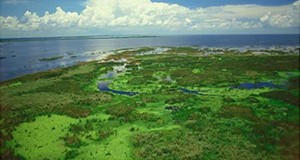During the summer, many of Florida's nutrient-enriched lakes and reservoirs experience proliferations of cyanobacteria commonly called “blooms.”. Cyanobacteria are natural in Florida lakes and reservoirs, but when they grow to high levels and bloom, they become a big problem. They look awful, smell bad, and can poison fish and other animals in the water. To help resource managers considering costly remediation projects or evaluating the effectiveness of nutrient reduction strategies to manage the problem, this 7-page fact sheet presents the results from 15 years of studies observing three large, nutrient-rich lakes in Florida (Lake Harris, Lake George, and Lake Okeechobee) to study the relationship between rainfall and cyanobacteria blooms and learn causes of year-to-year bloom variability. Written by Karl E. Havens, Mark V. Hoyer, and Edward J. Phlips and published by the Florida Sea Grant College Program
http://edis.ifas.ufl.edu/sg142
Tag: Lake Okeechobee Drainage Basin
Climate Change and Ecosystem Services of Florida's Largest Water Body: Lake Okeechobee
 Future climate change could result in higher temperatures and greater evaporative water loss in Florida. If these changes are not compensated for by more rainfall, the state’s largest water body, Lake Okeechobee, could experience prolonged periods of very low water levels and catastrophic loss of its ecosystem services, which are the benefits that people receive from ecosystems. This 6-page fact sheet provides background, optimal and actual water levels, projected changes in South Florida climate & their effects on water levels in Lake Okeechobee, their effects on ecosystem services, and possible remedies. Written by Karl Havens, and published by the UF Department of Sea Grant, June 2015.
Future climate change could result in higher temperatures and greater evaporative water loss in Florida. If these changes are not compensated for by more rainfall, the state’s largest water body, Lake Okeechobee, could experience prolonged periods of very low water levels and catastrophic loss of its ecosystem services, which are the benefits that people receive from ecosystems. This 6-page fact sheet provides background, optimal and actual water levels, projected changes in South Florida climate & their effects on water levels in Lake Okeechobee, their effects on ecosystem services, and possible remedies. Written by Karl Havens, and published by the UF Department of Sea Grant, June 2015.
http://edis.ifas.ufl.edu/sg137
Cattle Fencing BMP Can Reduce Phosphorus Loads from Florida Ranches
 BMPs are an important tool in helping the state and individual landowners protect and enhance state’s waters. Given the water quality issues facing Lake Okeechobee and other sensitive water bodies, the importance of BMP implementation has increased since their official establishment as part of the FWRA. In order to ensure that BMPs are reducing nutrient loadings, on-farm research is needed to verify BMP effectiveness. A four-year study was conducted to evaluate the effectiveness of the cow/calf stream fencing BMP. The study concluded that the BMP did reduce the amount of P being discharged from the ranch. This BMP should continue to be included in the cow/calf BMP manual, and, hopefully, its widespread implementation will help the state in meeting its TMDLs. This 3-page fact sheet was written by Sanjay Shukla, Wendy D. Graham, Alan Hodges, and James M. Knowles, and published by the UF Department of Agricultural and Biological Engineering, May 2014.
BMPs are an important tool in helping the state and individual landowners protect and enhance state’s waters. Given the water quality issues facing Lake Okeechobee and other sensitive water bodies, the importance of BMP implementation has increased since their official establishment as part of the FWRA. In order to ensure that BMPs are reducing nutrient loadings, on-farm research is needed to verify BMP effectiveness. A four-year study was conducted to evaluate the effectiveness of the cow/calf stream fencing BMP. The study concluded that the BMP did reduce the amount of P being discharged from the ranch. This BMP should continue to be included in the cow/calf BMP manual, and, hopefully, its widespread implementation will help the state in meeting its TMDLs. This 3-page fact sheet was written by Sanjay Shukla, Wendy D. Graham, Alan Hodges, and James M. Knowles, and published by the UF Department of Agricultural and Biological Engineering, May 2014.
http://edis.ifas.ufl.edu/ae501
Common Aquatic Plants of Lake Okeechobee: Identification, Value, and Management (SSAGR362/AG371)
 Aquatic and wetland plants are essential to the ecology of Florida lakes, such as Lake Okeechobee, but they can also pose ecological and water use problems. This 16-page fact sheet provides information about the plants of Lake Okeechobee and outlines the importance of certain plants to the lake, problems caused by some plants, and the methods used to manage plants for the benefit of the entire lake environment. Written by K.A. Langeland and C.C. Jacono, and published by the UF Department of Agronomy, July 2012.
Aquatic and wetland plants are essential to the ecology of Florida lakes, such as Lake Okeechobee, but they can also pose ecological and water use problems. This 16-page fact sheet provides information about the plants of Lake Okeechobee and outlines the importance of certain plants to the lake, problems caused by some plants, and the methods used to manage plants for the benefit of the entire lake environment. Written by K.A. Langeland and C.C. Jacono, and published by the UF Department of Agronomy, July 2012.
http://edis.ifas.ufl.edu/ag371
The Long-term Contribution of Phosphorus from Agricultural Lands to Lake Okeechobee (SL357/SS558)
 This 7-page fact sheet uses a new procedure to evaluate the soil from active and abandoned dairies in the Lake Okeechobee watershed to determine their potential to negatively impact water quality through phosphorus release. Written by V.D. Nair, M. Chrysostome, and W.G. Harris, and published by the UF Department of Soil and Water Science, October 2011.
This 7-page fact sheet uses a new procedure to evaluate the soil from active and abandoned dairies in the Lake Okeechobee watershed to determine their potential to negatively impact water quality through phosphorus release. Written by V.D. Nair, M. Chrysostome, and W.G. Harris, and published by the UF Department of Soil and Water Science, October 2011.
http://edis.ifas.ufl.edu/ss558